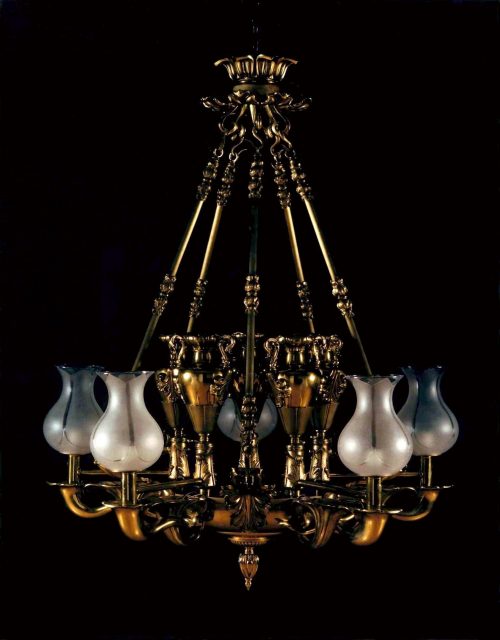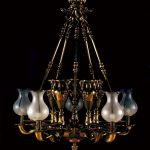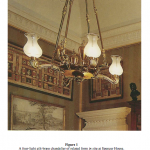9699 A FINE REGENCY GILT BRASS COLZA CHANDELIER English. Circa 1820. Measurements: Height: 46″ (117 cm) Diameter: 37″ (94 cm)

-
Figure 1
Research
Of gilt brass. The corona cast with lotus leaves above a canopy of acanthus leaves, the body, suspended on five supports, each with acanthine decoration, the five foliate arms, each arm terminating in a foliate drip-pan and nozzle, the whole centered by five oil reservoirs, each in the form of a Grecian urn, the whole terminating below in a lotus leaf final.
Provenance:
The Collection of Sir Evelyn de Rothschild
The present colza chandelier is a fine and unusual example of a ceiling-hung light from the Regency period. London chandelier manufacturers such as Messenger & Sons and William Collins produced sumptuous and costly lighting employing colza oil as fuel for the great English houses of the early 19th century. Colza oil is derived from the rapeseed, “an extremely viscous liquid, too thick to be drawn up the wick with capillary action, so the reservoir had to be placed higher than the wick, enabling the oil to run down to it by the force of gravity.”1
In the case of the present chandelier each of the five burners has its own individual reservoir of stylized classical amphora form. The chandelier is further distinguished by the unusual modeling of its arms, each conceived as a double entwined cornucopia. This previously unseen design feature of Regency lighting probably alludes to the chandelier’s specific positioning within a grand dining room. In antiquity the cornucopia represented plenty and is often seen with an abundance of fruits spilling from it. Almost invariably, Regency brass chandeliers were gilded in a specifically English technique using a form of gold pigmented lacquers whose color could be regulated by the use of directly-applied heat.
A four-light gilt-brass chandelier of related form is shown in figure 1, in situ at Spencer House.
Footnote:
1. Bourne, Jonathan, and Vanessa Brett. Lighting in the Domestic Interior: Renaissance to Art Nouveau. London: Sotheby’s, 1991. 132.


Comments are closed.